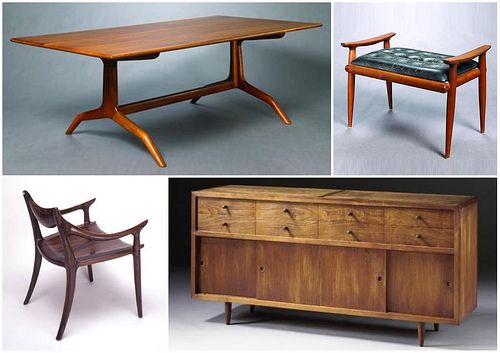
It is obvious that Sam Maloof was influenced by mid-century Danish Modern furniture. These are all Maloof pieces.
When the two lions of our craft, Maloof and Krenov, died in such quick succession, it felt like the end of an era for many of us. Check out this insightful letter by Peter Korn of the Center for Furniture Craftsmanship (Fall 2009 newsletter). This feeling he expresses so eloquently –““For woodworkers of my generation, it is an uneasy transition.
We find ourselves stationed on the front lines of life, with no one marching ahead”–brought me back to a few questions I’ve pondered in the past:
While Maloof and Krenov certainly created the template for the modern studio furnituremaker, did they usher in an identifiable furniture style? As Korn points out, Maloof and Krenov were a study in contrasts, both in personality and how they designed and built furniture.
Recently, however, while the art director and I were looking for a modern credenza to go under a flat-screen TV, we may have stumbled onto the answer.
To some of you, this will be no surprise. Scandinavian furniture, specifically Danish Modern, binds together a lot of 20th century furnituremaking.
Once you discover the work of Finn Juhl, Hans Wegner, Ole Wanscher, et al, it is hard to see Maloof, Krenov, Nakashima and others as American originals. As most of you know, Krenov trained for 30 years in Sweden, and while Maloof never really admitted it, his work, especially his early stuff, is very similar to Wegner’s and others’. By the way, Tage Frid, one of the founding contributors of Fine Woodworking magazine, was born and shaped in Denmark, and his furniture showed it. Check out the mid-century Danish stuff available in online galleries. Here are two good ones: Dansk Møbelkunst and Danish-Furniture.com. The designs are surprisingly fresh.
Our most recent Readers Gallery (FWW #210) is dedicated to recent work by Krenov’s students, many now masters in their own right. And there I can see many hewing even closer to the Danish Modern line, maybe even some without knowing it. Does that mean this influential style has legs, so to speak? Is it strong enough to survive into the 21st century? I think it is. It has a clean modern look, yet it is emininently functional and undeniably handmade. And wood is the star, though the style accepts metal and other media nicely. I’m interested to see where modern makers will take it.
It is easy to look back on furniture history, and see how 18th-century styles, followed by Shaker and Arts & Crafts, each arose from a specific culture and commercial context. Is it even possible for a cohesive style to coalesce out of today’s fractured culture, with mass-production of disposable goods dominating commerce? And does Danish Modern hold the key?
Lots to chew on here. What do you think?

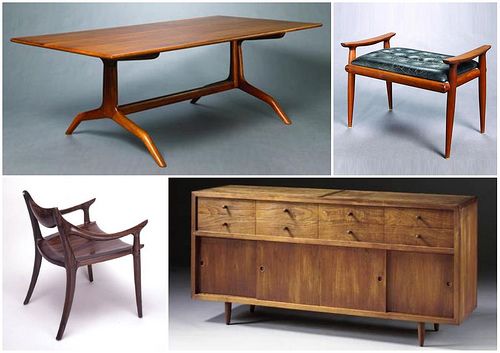
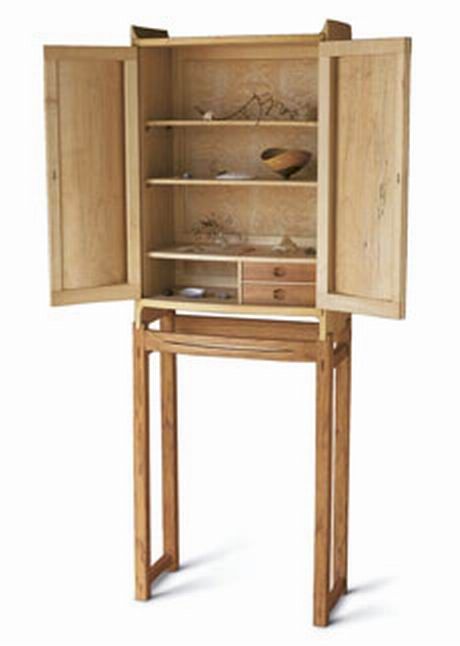

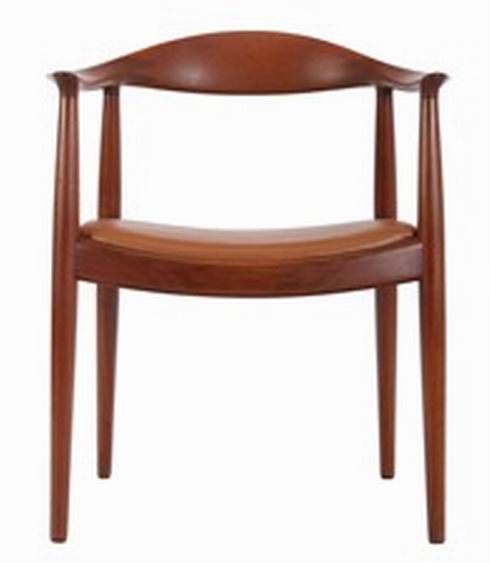
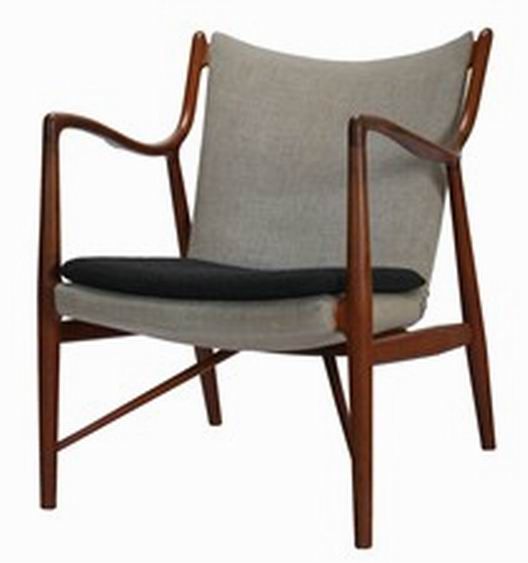
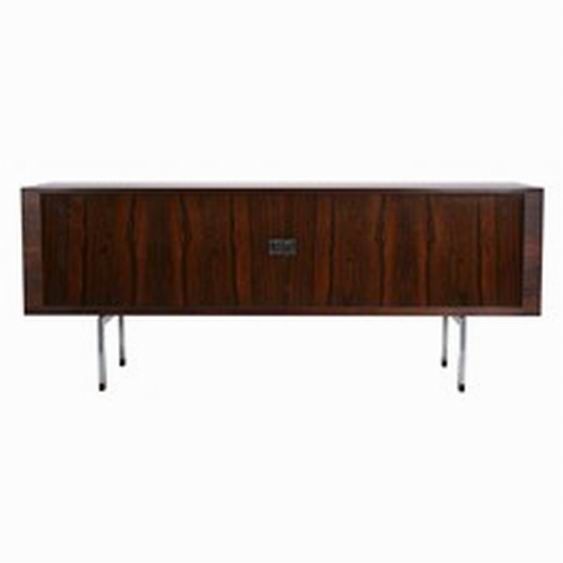
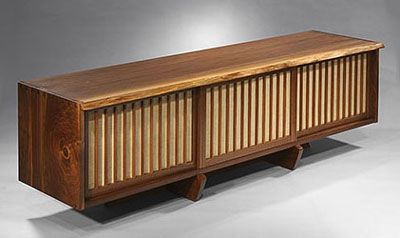
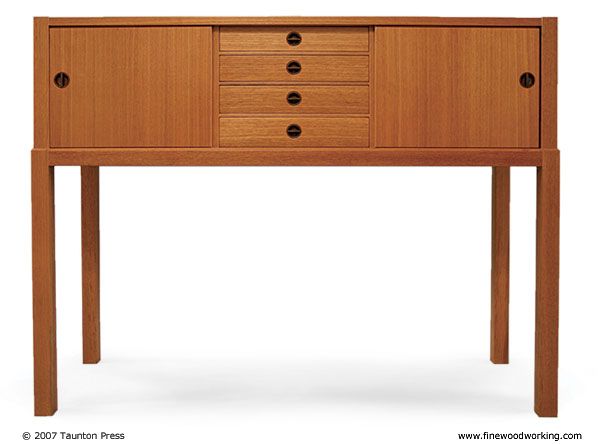
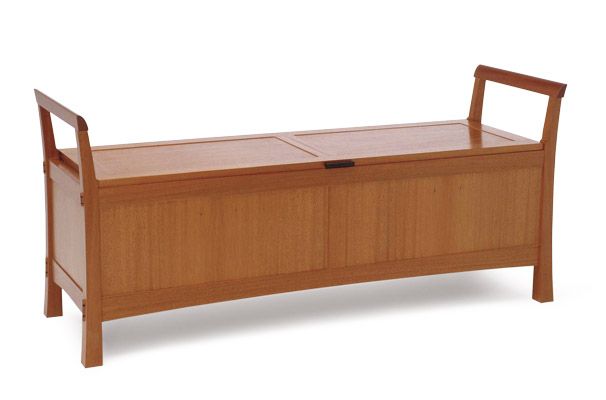
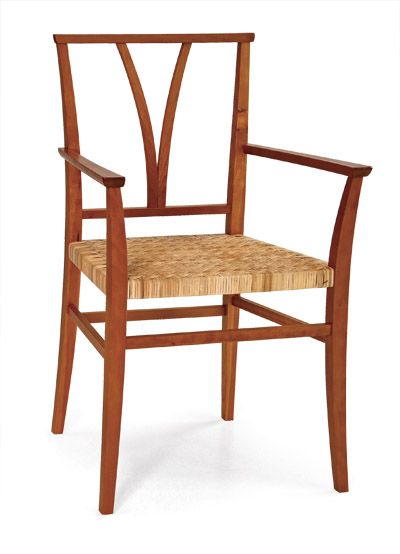






















Comments
Asa,
VERY interesting! You struck a cord, as Neil Lamens and I touched on this very topic in October 2008. I invite you to listen to the mp3 podcast I posted on my blog, at http://sandal-woodsblog.com/2008/10/10/neil-lamens-on-design-form/ . Today I also made an entry at my blog, highlighting your article. Thanks for introducing this intriguing notion at *this* particular time!
- Al Navas
OK, so I guess I'll start. I don't like this furniture style. Krenov, Maloof, Danish Modern -- it all looks too 1950s to me. Too skinny, like a gawky teenager. I keep expecting to see chrome legs.
I realize that I'm being a bit heretical, but my hope is that this style does not beget the style of the 21st century.
Don't ask me what I'd prefer in its place, because I don't know.
OK, so I guess I'll start. I don't like this furniture style. Krenov, Maloof, Danish Modern -- it all looks too 1950s to me. Too skinny, like a gawky teenager. I keep expecting to see chrome legs.
I realize that I'm being a bit heretical, but my hope is that this style does not beget the style of the 21st century.
Don't ask me what I'd prefer in its place, because I don't know.
I love everything about this furniture, It's the stuff I aspire to build.
Hello!
As one of three teachers of cabinetmaking at the Copenhagen Technical College, I have the chance to experience in different contexts the impact that the Danish Modern style continues to have on the Danish cabinetmaking scene.
At the same time that the national design and architecture museums regularly revisit the themes explored by the architects, designers and craftsmen of the golden era of Danish Modern, my students, willfully or unknowingly, continue to create during the school periods of their apprenticeships new and unique pieces furniture that echo the Danish Modern style.
Granted, these students have grown up and have cut their cabinetmaker teeth surrounded by these icons of design. Nonetheless, they work with their projects within the context of design summed up in the words of Arne Jacobsen: Good design is when you can't remove any more elements. How true.
Personal preferences? I won't discuss these. Good woodworking and relevant design? This is the essence of any good piece of furniture. Danish Modern, as a style in itself or as a source of inspiration for new design, will be with us for a long time.
Asa,
The media has power over the effects of such things, but history always has the last word. As for my experiences when I would mention such names as Maloof and Krenov to non woodworkers the response would be “who?” and when I showed examples of their furniture I would get silence from most. But showing them pieces of furniture from the valued price Chinese stores would by their own admission define this as the style of the times.
I try not to define such things but hold personally to what has influenced my interests over the years. I admire both masters’ works and have built in their styles, I would enjoy knowing that in some future time they were chosen as the ones who styles has been defined for our times. But to try to define such things is like attempting to predict next year’s economy.
Don
Great comments here. I'm especially flattered that a teacher of cabinetmaking in Copenhagen took the time to respond. I love that quote from Arne Jacobsen.
And I'll check out Al Navas's podcast and blog, right after Christmas. Right now, my wife and I are waiting for our youngest daughter to be sleeping soundly enough for us to put Santa's deliveries under the tree! Happy holidays, everyone.
--Asa Christiana
Maloof, Krenov and Nakashima's linkages with the Danish style are certainly obvious. What I personally did not learned until recently is that the Danes' took direct inspiration from the Chineses. On teh excellent Dansish-furniture.com you see a picture of a chair by Wegner called the Chinese Chair, a design dated 1944. If you Google "chinese horseshoe chair", you'll find links to pictures of very similar designs from the age of the Ming dynasty! You can clearly see the evolution from this to the signature pieces Wegner created 4-5 years on (The Chaire and the Y-Chair).
Does that make Maloof, Krenov and Nakashima's work less original? Not to me. Does creativity automatically calls for complete uniqueness? A total break from history?? I love the Danish style and how it evolved in America in a style of its own. As a hobby-woodworker, I try to relate to these fantastic designers/crafstmen in my own little explorations with chairs. Thinking that someone in Danemark, California or China may have been - so many years ago - taken as I am today by a specific curve is quite something. It gives me a sense of connectiveness. Now, I'm probably just telling tales to myself. But they do make me feel good as I retreat to my shop.
Krenov and Maloof's work was undoubtedly influenced by Scandanavian designs, however both were extremely innovative and original.
I do not believe a new furniture style has taken hold and surpassed Danish modern. At some point someone will vocalize a new movement through their work and words that will create a following of craftsmen and users. Is that person creating now?
@Ieronymus
You quote Arne Jacobsen: Good design is when you can't remove any more elements. And you say "How true."
That is definitely a personal preference, don't you think? Not everyone will agree with you.
For example, read "From Bauhaus to Our House" for a dissenting opinion.
I'm still pondering the quote from Arne Jacobsen: "Good design is when you can't remove any more elements."
Surely that's not the only thing that characterizes good design. By that measure, Ikea particle board bookcases would qualify. They do a fine job holding books, and it's hard to remove any more elements. If you do, they'll fall down. But do we want them in our homes? Not me.
So what's being left out of that formulation? I suspect that at least part of it is "personal preference" element. What looks good to your eye?
George Walker has a great blog on design that addresses questions like this.
http://georgewalkerdesign.wordpress.com/
Ultimately, I don't believe that the Jacobsen quote is any more helpful than the old joke about how to carve the statue of David: start with a big block of marble and chip away anything that doesn't look like David.
Rather influenced by the Shaker's style, table and drawer case expecially, and in a more marked way, by the so called (here in Italy, at least..) the "Swedish style" of the fifties and the sixties, I dare say.
That could be understandable as myself, a couple of years ago, built a drawer case with 27 (yes twentyseven) drawers of 15 different sizes and a door. A few months afterwards, attracted by a photo in the cover, I bought a book in London (England) about all the aspect of the Shaker Community and with a great surprise, I found there something very similar to what I had drafted and done. I didn't even know the existence of a Shaker Community before. Do you believe in reincarnation???
The home shop does have its place.
Nobody with the credentials to establish a period in furniture history is going to base it off of the American Woodworking hobbyist.
For reasons unknown, I’m unable to read Mr Korn’s NewsLetter but I am of the Maloof/Krenov generation and with all due respect, nobody is marching ahead because the parade has passed you all by.
For those of you who have made their living through furniture design and manufacturing, changing approaches to technique is the norm. In response to the market, all sorts of materials, finishing techniques, and if at one point you were a hot custom shop, you learned of PETA years before it gained national recognition. I ask you right now, how many of you reading this post will know what I mean by bringing up PETA and furniture making? I’m certain many of you will not make a connection.
My generation turned American woodworking into a hobby. And for those of you, who have been following my thoughts along the internet highway, know of my disgust as I see it now being repeated again. I’ve stated this before, those of my generation who teach studio craft at the University level have gotten lazy, those who seek advertising dollars have revisited the “how to” of the craft again, rather than to push the hobbyist to new heights. Please I understand why, but it muddies the water in the internet woodworking community. Even the reference that Baudi makes about a design blog is a revisit and regurgitation. The blog may spark thought, but it sparks thought to back yonder.
The Craft Movement of Maloof and Carpenter has been defined already and it has been over for quite some time. The Studio Furniture definition has changed, but the learning circulumns have not.
Seeing the opportunity to advance awareness, I posted on my blog and challenged bloggers who were covering a particular event to raise the level of dialog about the craft. The jury is still out. It may be of conflict but here’s the link for those interested:
http://furnitology.blogspot.com/
Few are aware but it is a very exciting time right now in furniture design and manufacturing. We are behind. Unfortunately, the community would rather argue the thickness of a wood shaving, or just copy the work of others. There are many more than just these two that are silly and project immaturity within the craft. My favorite statement is the thoughtless classic, “I wouldn’t have that in my house”.
I believe there is a place for the home and basement shop but before a period of furniture can be defined through the home and basement shop, certain criteria must be presented and acknowledged.
In late February 2010, I am speaking on this topic at the WOODWORKING EXPO presented by Thomas J MacDonald being held within the New England Home Show, if you are in the Boston area stop by.
Neil Lamens
This link http://www.designboom.com/eng/education/folding/onlevel.html may give some hints about the sources of inspiration to some of the great danes :-)
Compare the Wegner folding chair to the predecessors.
/Niels (from Denmark)
Neil,
Wow, what a rant! Maybe after you calm down a little you can post again and explain a few things, like why you have such contempt for home woodworkers. And what is it, exactly, that disgusts you so much -- are you really that upset that people want to learn how to sharpen and tune their hand planes?
Oh, and how is it that a guy who is "of the Maloof/Krenov generation" looks to be around 40? What's your secret?
Me, I'll just be waiting here, tears streaming down my face, waving at the parade that passed me by as it recedes into the distance.
David
Here's what I got out of the Jacobsen quote: A little goes a long way, basically. We have to evaluate a lot of furniture at FWW, for the Readers Gallery, for projects, etc., and probably the most common problem pieces have is trying to do too much: too many types of wood, too much contrast, too many eye-grabbing details battling for attention, and so on. Jacobsen argues for artistic restraint, which is almost always a good thing, especially in the long run. The piece that shouts at you can become abrasive over time; just like simple elegance in lines, proportions, and details will grow on you.
--Asa
Asa,
That interpretation of the quote is certainly something that I can agree with. I wonder if that's what Mr. Jacobsen intended, however. Take a look at his designs here, for example.
http://www.bonluxat.com/d/arne-jacobsen.html
They seem far from restrained, to my eye at least.
David
Neil,
Do not denegrate the hobbyist. I have known hobbyists that are more than mere copiers but create amazing pieces. The thing that holds them back from becoming great furniture maker/designers on an international scale is the small body of their work.
Dan
Design is filled with one liners that sail across a profession for a while. They come to define a fashion ..."architecture (or good design) is but frozen music..."and are useful in explaining a style but are silly when attempted to be applied as an ultimate standard.
Remember Mies van der Rohe proclaimed "less is more," which sounds like a more concise formulation of the Erickson quote. But does it work? Think for a minute of the modern black filled canvas in an art museum (the ultimate less) compared to Hieronymus Bosch's somewhat chaotic "Garden of Earthly Delights" Sometimes in design more is better and less is less. That's the problem. There are no universals.
Even the much vaunted notion of the golden section and proportion rests on a a false belief that eye works like the ear and see ratios like the ear can pick out pure mathematical ratios of sound waves. Unfortunately we rarely see furniture or buildings in pure elevations where the ratios are constructed. We can't see "frozen music."
Explaining why we like something over something else is difficult. Be wary of editors who proclaim only three elements can be contained in a piece of furniture or a food critic who thinks that sometimes the most exciting cooking can't come from home cooking. In the end I think out of basements can come some extraordinary wood working projects, from people with limited skills who just didn't know better, smiled and said "why not."
Peter
Peter,
I was with you right up until "we can't see frozen music". I'm not sure about that.
Jim Tolpin has a great exercise on page 1 of his book "Measure Twice: Cut Once." He shows two tables, identical except for the relative proportions of the top and the apron. The table designed according to the golden ratio looks fine, the other just looks wrong.
You can see it if you "Look inside the book" on Amazon.
http://www.amazon.com/Measure-Twice-Cut-Once-Woodworking/dp/155870809X
So, maybe we can't see frozen music, but maybe we can see frozen discordance? If almost everybody who looks at those two tables agrees which one looks best, what does that tell us about design? Have our eyes have been trained to respond that way since infancy, or is it somehow more "built in"?
Or maybe we can agree about simple forms like those tables, but more complicated forms are not so easily judged?
David
I think sometimes we take the whole issue of copying way too serious. As you can see Maloof was inspored by some thigns other people had done, but he took it to a whole different level. I have built a Maloof inspored rocking chair. It is not a copy, but I was certainly inspired by his work.
Isn;t that what it is all about. Inspiring others?
David,
Maybe the original question should not be is Danish Modern the style of our time, but rather is Danish Modern about to become very popular again. I used to quote that we love what our grandfathers made and hate what our fathers did. There is is something romantic about a style and age not remembered clearly. Back before my fathers time was a golden age. Perhaps that is why craftsman furniture is having such a revival. But as today's children get older they seem to be looking at the period of their grandfathers....which might explain why hairpin legs and sliding peg board doors are gathering attention.
There are many elements beside proportion. Palladio is famous for designing buildings based on pure ratios (like music), rooms set 2:3, 3:5 with even the ceiling heights of each room clearly worked into simple whole number ratios. Except with foreshorting and oblique views we never really experience or can perceive the ratios we are looking at. It gave Palladio a reason,the rules of the game for what he put down. But is it really perceptually better than a gothic church where many of proportions are controlled by a square and it's diagonal or 1:1.414...... I'm not sure you could make the case. In either case the pursuit of proportion results in repetition and similarity which go a long way to hold something together. In short I don't think there are any magic solutions or rules for design. Sometimes it works. Sometime it sings Sometimes its an ugly, but useful folly.
It will be interesting to see what people do in pushing the bounds of Danish Modern, to make it fresh for people today. But in some ways I feel that It has been pushed to its limits, sometimes to the point of being ridiculous already. We'll see.
Peter
Very interesting discussion....I wish I could add to it from a "hands on" point of view but, as a guitar maker for over 35 years, my designs are (reasonably) dictated to me by history and customers desire to "get what they are used to seeing". As to Danish Modern (and Mid-Century Modern), A few years ago I came across a set of furniture (dining table & chairs, credenza, china hutch, end table, coffee table) at a garage sale that I bought that was built in the mid 50's by an American company (Drexel). As I read up on the line (Declaration) I came to understand that it was this American company's answer to Danish Modern.....made w/ Walnut instead of Teak / Rosewood. I loved the lines immediately and saw some Maloof in it the moment I laid eyes on it. Not only is the furniture very well made but the clean lines are so comfortable to live with. I can remember growing up w/ similar furniture as a child but this was the first time I "saw" it. I've found some other pieces (a chest of drawers and a nightstand) and see such Danish Modern influences like the drawers on a stand and some subtle raking of angles. This is a beautiful period of design, one that has influenced our modern masters, and (most importantly) oe that is a delight to live with!
Greg
I guess I was not aware that Danish Modern (actually Scandinavian Modernism) had ever gone away.
Certainly the principal themes of the movement: simplicity, functional practicality, extensive use of natural materials with simple, easily restored finishes, and ease in manufacturing are still with us, underlying much of modern furniture design. In fact, combine the Bauhaus School and Scandinavian Modernist approach and you can easily isolate the principal influences on almost all modern furniture designers.
For reasons unknown to me, design genius struck Northern and Central Europe between the world wars. Virtually all modern design is merely a variation of the inspirations of Aalto, Rietveld, Charles and Ray Eames, Breuer, Mathsson, Jacobsen, Olsen, Malmsten, Wikkelso and the like -- almost all of them either Scandinavian or central European. I look at the new Herman Miller Aeron Chair and I see a Charles Eames chair revisited and updated for materials and manufacturing processes not yet invented in the mid-20th century. It's not new. It's just another interpretation of an existing theme.
I have enormous respect for both Maloof and Krenov. But when I look at their work I just don't see design genius. I see interesting variations on design themes perfected long ago -- and so persuasive, so different, so striking and so in tune with 20th century thought that nearly a century later we still refer to the designs as "modern".
The work of both Maloof and Krenov is inspired but not original. There is no evidence of a new insight or design philosophy, no abrupt change in the direction of furniture design, no distinguishing themes inherent in their work. It a variation on what came before -- in many ways an inspired variation -- but still only a variation.
Krenov was influenced by Malstrom, who is defined as the forerunner of danish modern. Malstrom was influenced by tne Barnsleys
ron
David - in your response to peter you talk about how the proportion that is "off" from the golden ratio looks wrong:
but that apron in tolpin's book) is WAY off - about 2x at least! in contrast with music, if two notes are off by even 5% they are considered to be WAY off... this whole analogy between frequency proportions in music and static/structural proportions in design just doesnt work for me. the ear is much more sensitive to minute variations, whereas in structure you can be a bit off the traditional proportions and pass by quite well.
im with peter :-)
aaron_k
Well, the reason I didn't reply to Peter's last post was that I agree with him too. :)
No fun if everybody agrees, right?
But my opinion of the entire modernist movement, from Bauhaus to hairpin legs, to curvy, minimalist chairs is: I don't much care for it.
Not sure where to go from there. No accounting for taste, I suppose.
David
Wegner,Malmsten,Aalto...is it really THAT interesting to find out what the new flavor is going to be?
Most woodworkers I know produce their pieces based on architecture, furniture, paintings and other input sources they found interesting with NO especial thought of time or period....where do you think thoose gentlemens got their ideas from? "Progress" and "IN-fashion" has always been nicking pieces from former artist AND been able to look forward...ergo...Horray for fallen masters!!...Horray for the magical women/men that will give us more to appreciate!
Furniture IS timeconsuming AND timeless.
Nearly all furniture design is derivative in nature. The only exception being those design elements made possible by, new materials, and methods of production.
The work of the Eames was truly original. But, only because the advent of plywood, and the mechanisms required to produce the thin sliced wood it required, coupled with modern adhesives, and pressure forming equipment, made ti possible for them to work in a new medium.
So long as we work with solid woods, and join it together, we can't do anything that isn't derivative of those who went before us.
Like 6-string, I like and own quite a bit of americanized "Danish Modern". Most of mine is from Lane's Acclaim line made from 1959 to the mid sixties. I started buying it in the late seventies when I moved out of my folk's house and could find it in thrift stores for less then I could by plywood, and cinder blocks to make a book case. A twenty dollar dining room hutch with the glass sliders, and doors pulled off has served me well for thirty years now. The contrast of oak and walnut, influences much of what I build myself. To read a bit on the Acclaim line, try this link: http://www.jetsetmodern.com/lane.htm My ex hated the stuff until the kids started toddling, and then she realized that those rounded corners and edges, were as kid friendly as any hard furniture could be.
The other "Danish Modern" lines I have are: chairs designed by Ib Kofod Larsen for Stellig, and imported in about the same time frame; and, a wall full of shelves and cabinets designed by Poul Cadovius, for Royal Systems, in the early fifties.
While I like, and have built a few other styles for others, my personal favorite is Danish Modern. It is the clean simple lines, exposed woods, and simple ornamentation, that make all of these works attractive to me, (and more satisfying for me to build). I think that this simplicity, and unadorned use of woods, that makes Danish Modern a definitive part of our "modern" culture. And, what will keep it a dynamic part of furniture into this century.
Has everyone who has remarked about this topic neglected the commercial aspects of "Danish Modern"? Seems to me the requirements for reproducibility have had a major effect on the designs and that is an opinion supported by more an a couple of the reference materials dealing with the genre, especially between the the two WWs and especially with respect to chair design. I don't find much being said about design for design's sake; instead I find a search for production values and the design and materials to enable them.
Jim MacMahon
I have always seen the Scandanavian style as timeless, and for the most part, non-trendy. It's easy on the eyes, the hands and soul in so many ways.
I was very drawn to Scandanavian style furniture, but I never realized when I was in my teens. I was too busy playing guitar and performing.
However when I moved out and started needing furniture for my wife and I, it was then, in retrospect, that I realized how long I'd been enamored with the lines, proportions, etc.
Fast forward a bunch of years and I now realize through my love of The Craftsman style that THEY (The Scandanavians) were not only heavily influenced by The Shakers, but they must have been aware of, and influenced somewhat, by Charles and Henry Greene, CR McIntosh, et al.
I still have a Scandanavian Gallery hardcover book somewhere! I think the time is always right for good furniture!
Happy New Year all!
Howard Emerson
howardemerson.com
Since I've spent most of the year repairing and refinishing Danish dining room sets, I agree sorta. What I see is that earlier Dansk stuff used Teak heavily. Don't know if you've priced Teak lately, but that characteristic ain't gonna continue long. Even veneer makes you breath hard before you reach for your wallet.
But, compared to earlier styles, the 20th century was all about simplicity. Art Deco (1925) is much less ornamental than Art Nouveau, throw in Arts-Crafts, Prairie School, etc. Formalism is out, and if they try it, we lop off their heads. Within that constraint, feel free to create all the simple, stark, unvarnished, natural finished, un-ornamented styles that you can come up with. I don't get the sense that tastes are going to run to ostentatious and elaborate any time soon.
It seems to me that attempting to designate any particular style as "the" one to have is futile. Modernists tried that at the end of the Nineteenth Century and what resulted was an enormous outpouring of mindless trash. The Bauhaus about destroyed architecture in their attempt to provide good design to the masses through industrial output. Abstract expressionism is just the ticket for adorning the walls of corporate offices where no one will really look at it anyway and as for twelve-tonal music? Shudder! Furniture is different. It has to do something and do it comfortably. What the Scandinavian designers of the period between the wars came up with was a very humanized Modernism. Much of it is very comfortable, though not all. The living room chairs my in-laws owned were horrors to get out of. However, their dining room set with sideboard sits proudly in my daughter's home. But is it the way of the future?
When the millennium turned there was a lot of discussion in art magazines about what post-post-Modernism would look like. The consensus was that figurative and realistic art was the way of the 21st Century. Does this in any way apply to furniture? Who can tell? All I know is that if you make a chair that someone sits in and sighs happily in comfort, you've got a good design. It doesn't matter what it looks like anywhere near so much as what it feels like. To my mind, the furniture of the future will be ergonomic, above all. Life is too stressful for most of us to abide an uncomfortable piece of furniture.
Are we collectively kidding ourselves?
For all of the American icons that Malouf, Nakjima, Esherik, or Wendell Castle, the dominant designs in Fine Woodworking magazine are Greene & Greene and Arts and Crafts, or Federation or Shaker styles, with a smattering of green wood rustic (Windsor style. (I didn't include Krenov, because his influence was on the way of work, not the 'style').
So where does Danish Modern fit? For me, it is another reference point. I'd argue that most of us are most influenced by un-named designers - designers who produced the furniture we grew up with...
If we are so darned modern, why are there so many reproductions of Eames chairs or Bruer chairs out there? And why are non-US designers like Sergio Rodriquez almost invisible?
I'm not sure that I have any answers. I suspect that we should quite early on decide if we are to make 'art' or furniture. I'd rather make some nice pieces that people use and enjoy and keep.
Different strokes for different folks.
In the early fifties a family moved in a few doors down. One of their sons became a life-long (55 yrs) friend. They are Danish. Their furniture was all Scandinavian. TEAK! It was beautiful.I'm sure that it influenced my views on what I enjoy in wood. There were few harsh lines, unlike the easy? to produce Shaker and Arts & Crafts styles touted by the likes of general American tastes, hence the adoration of the European trained artists like Maloof and Krenov etc.
I was further amazed that the furniture of my Danish friends was NOT Danish modern, most of the pieces had been inherited from their families (pre-war that is to say the first one). The style is timeless. Now that I'm interested in producing my own things, in my own home I have a few problems. Teak is a rare commodity if not extinct, the curving shapes can't be duplicated on a table saw (labour intensity) and I don't have Scandinavian DNA!
Thanks for the forum.
Design has always seemed to be a reaction to the previous style. Wandering through the Milwaukee art museum my wife pointed to some Biedermeier furniture. "Look how modern it looks," she said. It did, almost like something out of the streamline design of Art Deco. It was done sometime around 1810 as the Germans (Austrian?) designer stripped away the frills and decoration of popular French furniture in disgust.
We tend to forget history, or more likely can't possibly know everything. Design has always been built upon what came before. It should not be a surprise that Malouf's work looks like similar to what someone else made at a similar time. We borrow, make reference, steal and combine. Occasionally it appears fresh and new. But years ago my pottery teacher, reminded me, laughed and said "... there's nothing new under the sun."
Danish Modern, I think is but one part of a long movement carried through the arts and crafts, influenced by the Bauhaus reaction to World War I, the folk traditions of Scandinavia and carried on today. I was surprised by how far back the roots go. Before Biedermeier , I'm sure there was some one else. Going forward someone will combine things in an interesting way and someone will say: looks like its based a Saarinen, a Castle, a Krenof, or van der Rohe. And they will be mostly right. But something will be fresh and new. As were, are the way materials, function and form are combined in Danish Modern.
"Krenov was influenced by Malstrom, who is defined as the forerunner of danish modern. Malstrom was influenced by tne Barnsleys"
Sid Works:
I am familiar with Edward Barnsley. Is there another one?
Edward Barnsley is the son of Sidney Barnsley. there were Ernest Barnsley (Sidney's brother) and Ernest Gimson who all worked together and were players in the English arts and craft movement. They were part of the Cotswold group.
Malstrom worked for one of the Barnsleys during the 1st WW period
ron
Bandit1156 below is touching the edges.
First let me just answer Baudi.....I should have said a product of the Maloof/Krenov era. As for the secret, you are generous classifying me in the 40 year old camp, I'm much older and the secret is that mental and physical hardwork enables a good night sleep.
Also....the comment by PurdueDan is an indication he like many, many others do not know my work on the internet. That's OK.
Getting back to Bandit1156; the stated comment of:
"And why are non-US designers like Sergio Rodriquez almost invisible?"
This is a start that hits the nail on the head but it lands beyond just furniture design, for instance with all our computer use today, why is Ives a British designer head of Apple's design. There are some american designers behind the scenes, but the next Jasper Morrison..... no where to be found, but what are we doing, "re-visting" what Krenov did, and keeping American woodworking as a hobby. Which I have no problem with, it's an indication as a society some of us can creatively use our leisure time working a "craft". Again, I enjoy the internet woodworking community as a result.
There is a new paradigm that the US is behind in, yes the parade is passing by. I have written a rather lengthy essay on this and the reasons why. It would be a conflict to post a link and rehashing would not do justice.
PM me if you are interested to read my first hand and studied thoughts. Barriers of entry have changed.
Neil Lamens
Happy New Year all, I would just like to know how the Danes are able to bend plywood like they do.
there seems to be alot of b.s. here and a few stroking themselves from what it appears.
Danish modern is just a link in time, or a part of the evolutionary process. it got it's influence from times past as have most things. the only things now are that trends are formulated by marketeers and the sheep follow along.
to put Maloof, Krenov and Nakashima of having the same influences is a crock. 3 entirely different approaches to their work aesthetically and constructively.
I doubt that the home hobbyist will ever set the standards in the evolution of furniture. I am not saying that they do not do good work though anyone with enough time to spend to do something should be able to do decent work. this is all secondary to them as they do not feel the pressure of having to make their living from it. It is the diehards who have eaten, slept and pooped this stuff for their lives such as the forementioned; such as the Barnsleys, Malstroms, Krenovs, Maloofs,Nakashimas and many others who set the parameters of work.. these Guys did not step out as designers to formulate their careers, but who were workers and through their determination and approaches to aesthetics and contruction evolutionized the way that we look at furniture. it didn't all come at once either, but many subtle changes over the years.
I believe though that it is the likes of wendell Castle that may have lit more fires in our heats without us really being aware of it. there are lots that were more than likely put off by his work as being to much on the art side at that time, but borrowed more from him then they let on.
Now if it wasn't for the influence of modern media where would woodworking really be.
Fine Woodworking was something that came along at a time and brought it from a dormant state
times have changed and it is not the workers who will set the trends but the "designers for industry", marketers and manipulators
Just strive to do your best and happy new year
ron
Sid Works......nice post, but Bandit1156 (about 4 to 5 down)isn't sure and asks why we are where we are???
I could quickly throw out that my generation drank the Krenov cool-aid and decided to go the bohemian route listening to the swoosh of a shaving while starving instead of sticking there nose in the dust and getting dirty while manufacturing like Maloof.
But that's not a fair answer......partially true but too light on substance.
Furniture form has always been created by the "designer of the industry".....lets just take Edward Wormley or Paul Evans, for instance, they were "designers of the industry". Marketing has always been there, manipulators have always been there. The approach has changed. We are in the midst of a furniture period as I type, Arad's show just finished at MOMA, we just don't see it yet and its a hard sell for a magazine. Although maybe if everybody keeps posting and pop up more Hans Wegner ads, maybe some extra coin will allow a chancey future read :^)
It surley is exciting but timing will not fit for most. Oh to be one of these young 16-19 yr old's who I see making nice stuff, the opportunity is there.
I have every issue of fww, I haven't opened a grey wrapper in 2 years . I just renewed again. I have always enjoyed it. It does have alot more balance then what is atated in the following comment that I pasted in..I guess one day that I will sit down and read them and see what has happened in the last couple of years. I came to this site what 3 or 4 years ago and was looking around and I could see the bickering in a thread about how to use epoxy to assemble furniture; well I almost puked and this is the 1st time that I came back.
I am usually pretty quiet
""For all of the American icons that Malouf, Nakjima, Esherik, or Wendell Castle, the dominant designs in Fine Woodworking magazine are Greene & Greene and Arts and Crafts, or Federation or Shaker styles, with a smattering of green wood rustic (Windsor style. (I didn't include Krenov, because his influence was on the way of work, not the 'style').""
well I can see that this fellow isn't or hasn't been been influenced by the icons as he can't even spell their names right.
Krenov was first known for his philosophy to us with his books and his work ethics. there are sure a lot of Krenov knockoffs out there and he seems to have morethan a few disciples out there teaching his work. I would say that his style has influenced the hordes.
""So where does Danish Modern fit? For me, it is another reference point. I'd argue that most of us are most influenced by un-named designers - designers who produced the furniture we grew up with...""
like I said ; danish modern is a point in time and there is still alot of it around,though most of what you see is commercial. most of us were not concerned about designers when we grew up. it is another of those words that is grossly over used,eg; designer-craftsman or they want to be called artists-another load of crap
""If we are so darned modern, why are there so many reproductions of Eames chairs or Bruer chairs out there? And why are non-US designers like Sergio Rodriquez almost invisible?""
Eames or Bruers chairs are manufactured as in an industrial manner they are more than likely cheap to reproduce.
Who is Sergio Rodriquez. what is his influence on studio furniture making?
""I'm not sure that I have any answers. I suspect that we should quite early on decide if we are to make 'art' or furniture. I'd rather make some nice pieces that people use and enjoy and keep.""
I don't know how you can decide on how to go out and make art for arts sake. One can make furniture that can be an object of art, but it has to have the qualities to make it so.
are you an artist who makes furniture or are you a furniture maker who's work can sometimes be acknowledged as an object of art.
just do your best
""It surley is exciting but timing will not fit for most. Oh to be one of these young 16-19 yr old's who I see making nice stuff, the opportunity is there.""
the sad part of this, is that most of these young fellows won't survive. most will not get the support nor the financial returns to keep them viable
This was a pretty good thread until the past day or two. Maybe the two guys who've been stinking up the place with their arrogance and negativity will go away now.
Nah... Probably not...
""This was a pretty good thread until the past day or two. Maybe the two guys who've been stinking up the place with their arrogance and negativity will go away now.
Nah... Probably not...""
""Don't ask me what I'd prefer in its place, because I don't know.""
a real positive statement!
-----------
some prople can confuse arrogance with honesty, but sir if you want to see negativity, you should look back at your own posts to view the positives
Thanks for your thoughtful response.It's exactly what I expected.
""Thanks for your thoughtful response.It's exactly what I expected.""
your quite welcome
discourse is healthy for the soul
OK, so I have a thought about the Arne Jacobsen quote bandied about in this thread: "Good design is when you can't remove any more elements."
My background is design in the engineering sense. This phrase runs through engineering design too. So my though it, does Arne Jacobsen mean this in the structural sense or in the aesthetic sense? Or a little of both?
I can see it in the structural (and economic) sense looking at the use of teak in some Danish modern stuff. It would be a sound decision to use only as much material as needed to do the job. Design a good joint and it will take the load. And by playing around with curves and tapers, you can get a "good" stick from what would otherwise be unacceptable if left square (think knots, splits, reversing grain). The use of subtle tapers is where I see the aesthetic sense of the quote.
Rob
Happy New Year, all.
I've really enjoyed the responses and discussion so far. I agree with most of the posts, actually. Of course, Danish Modern had its own sources, as almost nothing happens in vacuum. Also, it certainly has never gone away. My own opinion is that it has faded a bit from the American public's attention, as well as the North American woodworker's. I can't really speak for European woodworkers, or others.
I guess I hope that that changes, that woodworkers rediscover it in the way I did recently, and take it to new places.
A few questions remain from my blog: When historians look back in another century or so, and try to identify a dominant furniture style for the 20th century, will it be Arts & Crafts? Danish Modern? Something else?
And will any identifiable style coalesce in the 21st century?
Asa; are you talking Industrial trends for the masses or of the studio furniyure movement?
the 21st century could bring many surprises for the the inustrial trends as the turn to green evolves. I believe that we may see some new materials, whether they be exciting or not time will tell. Technology will dictate all.
there more than likely will be a greater split in the studio furniture making as technology advances. there will be the tradionists making furniture but going the way of the cowboy. there will a bigger swing to technology as it's cost come down for the small shop, and the ones who have the disposable cash will be buying the latest to put in their home shop and have the bragging rights to the latest.
I imagine material costs will soar and quality materials will be much more scarce
tomorrow will bring what it brings or what the marketeers decide what we should have
ron
Åsa,
The dominate furniture style of the 20th century will probably be labeled just "Modern," of which Danish modern is an offshoot. It may also become called industrial or post industrial. The modern furniture design people will be interested in laying out in a history will be the work of Bill Stump"s (sp?) for Knoll, the Eames bent plywood chairs, Erro Saarinen's pedistal chairs etc. All of these are investigations of ergonomics, industrial fabrication and use of new materials. For people interested in fine woodworking, this work has little to offer. Which is why you perhaps have looked to Danish Modern, and its skillful incorporation of wood. But Danish Modern is a branch, not the core of modern furniture movement. It sure can be beautiful though as one looks around and starts to notice examples.
又一伟大创举。
Danish modern is as much an outgrowth of the Bauhaus and the International Style as much as anything. And as to who the question as to who begat what; most involved in any design profession would agree that most design is really an iterative process. Style can be also much a response to machinery, materials, and economics, as much as anything.
However, given the souless excuse that for passes for residential & furniture design demanded by today's american public, we'll be lucky to be remembered for any contribution to design whatsoever. I'm still amazed by contemporaries who think nothing of spending a small fortune for for a technologically superior vehicle or the latest electronic gadget, and whose own homes are barren of any item with an element of design integrity or real style.
Thank you, Sid works, for your trenchant and apt comments.
I for one had some (Many) in my house.. I LOVE IT! And I also loved the old Spanish chunky things. I wonder why nobody likes Danish Modern or Old Danish for that matter.... 1960's ? I forget.
It was Trim and Proper.. Just like the new bride that entered their house. One big fan of Danish Modern furniture!
Another possibly indirect influence is notable. Some of the examples of Danish furniture at Danish-Furniture are very reminiscent of classical Chinese work, some of the chairs especially.
This furniture is so stylish and cool, it's the kind of furniture I want to see show up on our woodworking blog. I would also love to learn how to make these kinds of things. Especially that chair. It looks so neat.
I have always loved this style, since I was very young..I don't know if it is the furniture of our time, but it has definitely made a huge resurgence. There are lots of 'throwaway' types, but there are many more classically, well built, well thought out pieces that I would consider absoloutely timeless. I have done mid-century restorations for over 15 years now (http://www.toshmahal.com), specializing in mid century refinishing and restoration. Also we are beginning to build MCM inspired pieces with fine joinery and quality hardwoods/exotics. In my line of work, I have seen some of the best there is to offer and definitely noticed a huge surge in the interest. There are shops everywhere now that are selling it (I do work for many of them)...Much more than in the past. It has surely been on the upswing. I sure hope as in this realm of fine artisans we can take some of the best qualities of this furniture and carry them on.
Just some food for thought.
I read an interview with Sam Maloof where he was responding to criticism that over his career he relied to heavily on the same designs with very similar aesthetic. His response was (and I'm paraphrasing here) that he did this because he felt these designs were timeless and therefore he didn't need to update his thinking to better fit a changing aesthetic in late 20th century design.
I think this is especially relevant now that you've connected Maloof's style to that of Danish Modern. I believe the reason it has remained prevalent, whether directly or indirectly, is because of the timeless qualities it has that furniture lovers from many backgrounds can admire. Like Asa said, it is something that grows on you.
Log in or create an account to post a comment.
Sign up Log in